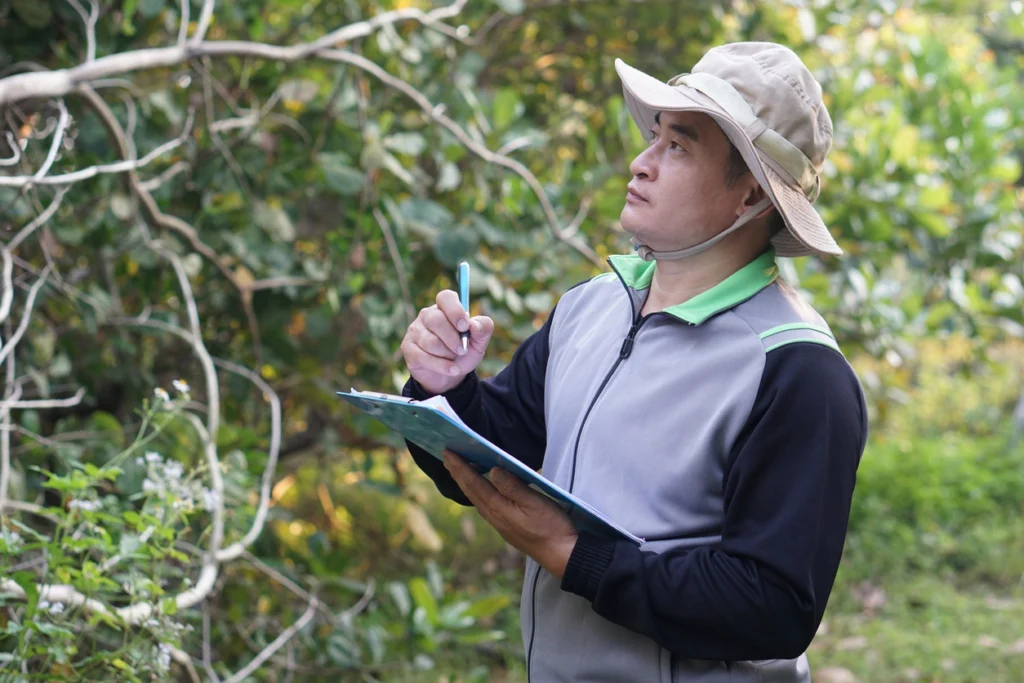Think of a biological survey as a detailed investigation of a specific environment. Scientists use systematic methods to identify, count, and assess the plants, animals, and other organisms found within a defined area. The different types of biological surveys provide essential information about the biodiversity and overall health of an ecosystem.

Why Categorize Surveys?
Biological surveys aren’t one-size-fits-all. Understanding the different types helps in several ways:
- Choosing the Right Methods: If your goal is to survey birds in a forest, you’ll need very different techniques than if you’re assessing aquatic insects in a stream.
- Analyzing Results: Knowing the type of survey conducted helps you interpret the data correctly. For example, a targeted survey for a rare plant will yield different insights than a broad survey covering all species within a habitat.
Types of Biological Surveys Based on Environment
Biological surveys span the Earth’s diverse habitats. Let’s explore some key types of biological surveys:
Aquatic Surveys: Exploring Waterways
From rivers and lakes to coastal wetlands and open oceans, aquatic surveys focus on life within watery environments. Scientists might assess fish populations, track algae blooms, or monitor water quality indicators like the presence of sensitive insect species. These surveys are crucial for understanding the health of aquatic ecosystems and the impacts of pollution or other disturbances.
Terrestrial Surveys: Surveying the Land
Forests, grasslands, deserts, and other land-based ecosystems are home to vast biodiversity. Terrestrial surveys involve methods for documenting plants, mammals, birds, insects, and more in these environments. Goals might include assessing habitat health, tracking wildlife populations, or identifying areas needing conservation attention.
Subterranean Surveys: Venturing Underground
Caves, underground waterways, and other subterranean habitats present unique challenges but harbor fascinating life forms. Specialized surveys illuminate these hidden ecosystems. Researchers might document cave-dwelling bats, unusual insects, or microbes adapted to life in darkness. These surveys help us understand the full range of biodiversity on our planet.

Surveys Based on Target Organisms
Biological surveys can zoom in on specific groups of organisms, providing a more detailed understanding of their roles within an ecosystem. Here’s a look at common categories:
Flora Surveys: The World of Plants
Flora surveys are all about plants. Scientists identify different species, map where they grow, and may assess factors like plant health or the diversity of a plant community. These surveys are essential for understanding forest composition, identifying rare plants, or tracking invasive species spread.
Fauna Surveys: Unveiling the Animal Kingdom
Fauna surveys encompass the diverse array of animal life, often focusing on specific groups:
- Mammals: Scientists use surveys to track mammal populations, map migration routes, or assess the health of mammal species. Examples include radio-collaring large mammals like bears or wolves, or conducting acoustic surveys to detect bats using echolocation.
- Birds: Documenting bird diversity, migration patterns, and breeding success are all goals of bird surveys. These surveys are valuable tools for monitoring overall ecosystem health, as birds are sensitive to environmental changes. Common methods include point counts, transect surveys, or nest monitoring.
- Reptiles & Amphibians: Surveys may target specific reptiles or amphibians, which can be good indicators of environmental health since they are often sensitive to changes in habitat quality or water quality. Techniques might involve visual encounter surveys, audio surveys for vocalizing species like frogs, or setting traps to capture and identify individuals.
- Fish: Fish surveys are essential for assessing the health of aquatic ecosystems, and they inform sustainable fishery management practices. Electrofishing, gill nets, or underwater visual surveys are some common methods used by fisheries biologists.
- Invertebrates: The vast world of invertebrates, including insects, spiders, worms, and countless others, plays a crucial role in ecosystems. Surveys help track pollinator populations, monitor beneficial insects in agricultural systems, or assess the spread of pest species. Techniques like pitfall traps, sweep netting, or light traps are used to sample invertebrate communities.
Microbial Surveys: The Unseen World
While less common in traditional surveys, studying microbes is a growing field. Scientists sample soil or water to analyze the communities of bacteria, fungi, and other microorganisms. These surveys have applications in assessing soil health, tracking potential pathogens, and even exploring how microbes can help in pollution cleanup.
Targeted surveys allow for a deeper understanding of particular species or groups and their intricate connections within an ecosystem.
Types of Biological Surveys Based on Objectives
The purpose of a biological survey shapes its design and the kinds of information it provides. Here are some key types:
Baseline Surveys: Setting the Stage
These surveys establish a starting point, providing a snapshot of the biodiversity and environmental conditions within an area. Baseline data is essential for comparison in future studies or for evaluating the effectiveness of conservation efforts.
Monitoring Surveys: Tracking Changes Over Time
By repeating surveys at regular intervals, scientists can track how populations, habitats, or overall ecosystem health are changing. Monitoring surveys might reveal long-term trends due to factors like climate change, habitat restoration progress, or the impacts of human activities.
Targeted Species Surveys: Zeroing In
These surveys have a narrow focus – finding a specific rare, endangered, or invasive species. Scientists use specialized techniques tailored to the target species’ biology and habitat preferences. The information gathered helps guide conservation actions or management strategies to control invasive species.
Impact Assessment Surveys: Before and After
Often used alongside proposed development projects, these surveys compare conditions before and after the project takes place. This allows scientists to assess the project’s true environmental impact, such as its effects on wildlife populations, water quality, or the spread of invasive species.
The objective of the survey dictates the approach, helping to ensure that the collected data is relevant and useful for making informed decisions.

Survey Techniques and Methodologies
The art of biological surveys lies in selecting the right tools for the job. Here’s a look at some commonly used methods:
Direct Observation Methods
- These involve directly seeing, counting, or capturing organisms:
- Counts: Scientists may walk transects, use binoculars, or set up camera traps to document wildlife.
- Trapping: Ethically capturing animals (using live traps or nets) for identification, measurement, or tagging.
Indirect Survey Methods
- Sometimes organisms are elusive, making indirect methods necessary:
- Track Identification: Studying footprints or scat to reveal the presence of certain animals.
- Nest/Burrow Surveys: Can provide evidence of species presence or breeding activity.
Sampling Techniques
These methods help standardize data collection and make results comparable:
- Transects: Walking a defined line, observing and recording organisms within a set distance.
- Quadrats: Using square frames to sample plants or less mobile organisms in a specific area.
- Plot-based Methods: Establishing designated plots for surveying vegetation or other organisms in detail.
Technological Tools
Technology expands the reach and precision of surveys:
- Remote Sensing: Satellite imagery and aerial surveys for mapping large-scale habitats or tracking land-use change.
- eDNA Analysis: Detecting traces of DNA from organisms in water or soil samples for non-invasive species identification.
- Bioacoustics: Recording and analyzing animal sounds to identify species, track migrations, or even estimate population density.
The right mix of techniques depends on the target organisms, the environment, and the specific goals of the survey.
Understanding Ecosystems: Building a Resilient Future
The different types of biological surveys are more than just gathering data. They provide the insights we need to act as informed stewards of our planet. Whether it’s protecting endangered species, managing resources sustainably, or mitigating the impacts of development, biological surveys are empowering decision-makers with the knowledge to shape a future where both human needs and the intricate web of life can thrive.
As technology advances, and collaboration grows between scientists, the public, and committed organizations, the power of biological surveys will only continue to amplify.
Frequently Asked Questions About Types of Biological Surveys
How do scientists ensure biological surveys are accurate and reliable?
Scientists prioritize accuracy through several means: standardized protocols to minimize variation between surveyors, quality control measures to catch errors, statistical analysis to account for natural fluctuations, and often repeating surveys to increase confidence in the results.
Can biological surveys be used to predict future environmental changes?
While surveys primarily capture a moment in time, long-term datasets become incredibly valuable for predictive modeling. Scientists can identify trends in populations or ecosystem health, and then build models to forecast how these might change under different scenarios (e.g., climate change or land-use pressures).
What are the limitations of biological surveys?
While powerful, biological surveys have limitations. They can be time-consuming and expensive, especially for large areas. Some species are inherently difficult to detect, and surveys might miss rare or elusive organisms. Scientists must carefully interpret results in light of these limitations.
How can biological surveys inform environmental policy?
Surveys provide the objective, science-based evidence that supports strong policies. For example, documenting the decline of a species is crucial for justifying its listing as endangered, triggering legal protections. Surveys can also demonstrate the effectiveness (or lack thereof) of existing policies, helping policymakers make adjustments.
Are there ethical considerations in conducting biological surveys?
Absolutely. Scientists prioritize minimizing any disturbance to wildlife or habitats. For sensitive species, the benefits of the data collected must outweigh any potential stress. Researchers adhere to strict ethical guidelines, and often must obtain permits before conducting surveys.